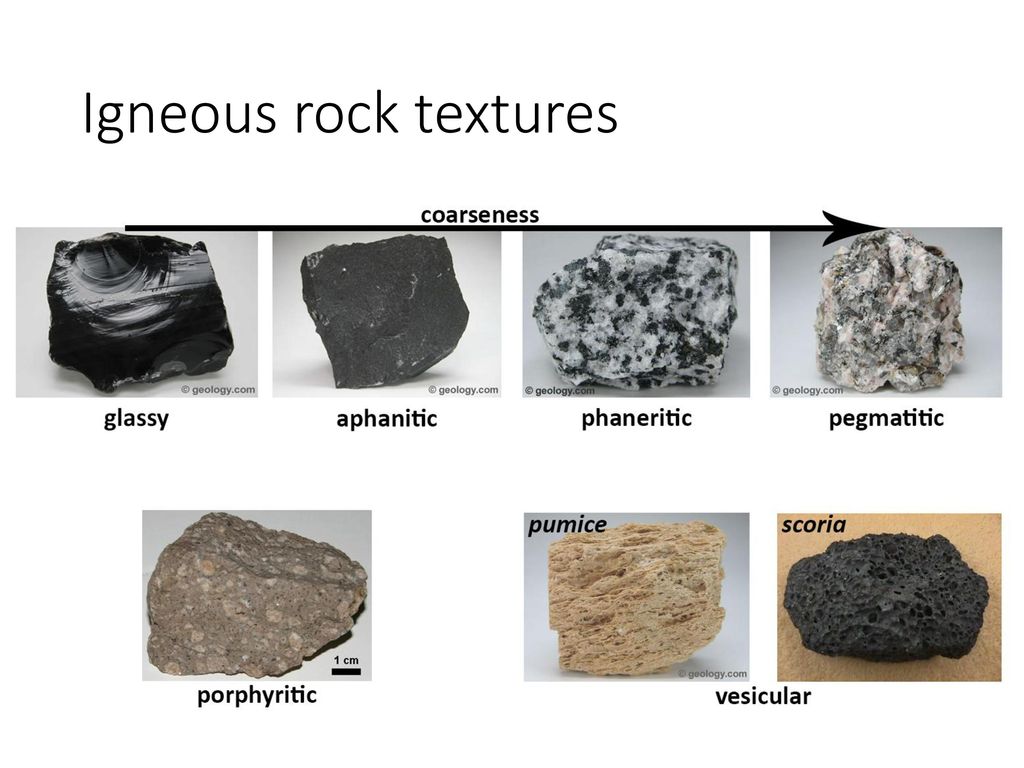Explain Why Igneous Rocks Have Different Textures
There are six main types of textures. Minerals can grow from the magma and separate from it changing the chemistry of the remaining liquid.
Refresher Lecture 3 Igneous And Metamorphic Basics Ppt Download
Now one of the most important reasons that you and your igneous rock friends look so different from one another is.

. Texture is comprised of grains and there are a few main types of igneous rock grains. Texture of a rock is the appearance of the rock and how one feels touching it. In many igneous rocks large mineral crystals float in a fine-grained groundmass.
Fine-grained rocks with abundant holes or vesicles extrusive. Igneous textures are used by geologists in determining the mode of origin igneous rocks and are used in rock classification. Equant grains are those with boundaries of equal lengths.
Phaneritic aphanitic porphyritic glassy pyroclastic and pegmatitic. Igneous textures include the rock textures occurring in igneous rocks. Other textures that may be evident on microscopic examination of igneous rocks are as follows.
Aphanitic a not phaner visible rocks. The igneous texture tells us how the magma cooled and solidified. This texture is found in granites.
Igneous Textures Crystal Growth. So the texture of igneous rocks is affected by the rate of cooling where. Phaneritic aphanitic porphyritic glassy pyroclastic and pegmatitic.
The three factors that influence the textures of igneous rocks are the speed of cooling the silicate content and the water content. Magma can solidify into igneous rock in several different ways each way resulting in a different igneous texture. Rectangular tablet shapes are known as tabular grains.
Granites are formed under the surface of the earth basalts are usually formed on the surface of the earth. Texture of Igneous Rocks. The texture of a rock provides a clue whether the magma cooled fast or slowly and where the rock was formed.
Phaneritic aphanitic porphyritic glassy pyroclastic and pegmatitic. Magma can solidify into igneous rock in several different ways each way resulting in a different igneous texture. Myrmekitic texture - an intergrowth of quartz and plagioclase that shows small wormlike bodies of quartz enclosed in plagioclase.
Once magma has formed inside the earth its composition may be modified. Igneous textures are used by geologists in determining the mode of origin of igneous rocks and are used in rock classification. There are six main types of textures.
There are six main types of textures. Ophitic texture - laths of plagioclase in a coarse grained matrix of pyroxene crystals wherein the plagioclase is totally. Igneous textures include the rock textures occurring in igneous rocks.
If the igneous rocks cools in the air like pumice gases will be trapped in the igneous rocks. Acicular grains are slender crystals. These can be broadly divided into five categories.
Think of the texture of something you would bake in the oven. The minerals are too small to recognize extrusive Glassy. The size and shape of the mineral grains or crystals and the pattern of their arrangement give a texture to the rock.
Start studying Igneous Rock Textures. While the igneous rock with a fine texture have an orderly arrangement of the atoms in the crystal and the crystals formed are too small that it cannot be seen by unaided eyes. If the igneous rock is formed under the water this will have an effect on the texture.
Magma may stay within the earth far below ground level and crystallize into plutonic igneous rock also known as intrusive igneous rock. Because they solidified from a fluid state igneous rocks tend to have a uniform fabric without layers and the mineral grains are packed together tightly. Extremely rapid cooling results in a texture like glass extrusive Vesicular.
The speed of cooling affects the texture because the faster the rate of cooling the smoother the rock will be finer texture aphanitic. Long fibers are known as fibrous grains and a grain that is prismatic is one that has different types of prisms. Textures of Igneous Rocks.
Learn vocabulary terms and more with flashcards games and other study tools. After having known various factors that define the texture types it will be easy to understand the important textures as exhibited by the igneous rocks. A pegmatite is an igneous rock formed by slow crystallization at high temperature and pressure at depth and exhibiting large interlocking crystals usually greater in size than 25 mm 098 in.
While igneous rock with a glassy texture is formed of rapid cooling of lava precisely due to quenching in water. Involves the addition of ions onto existing crystals or crystal nuclei For simple structures with high symmetry faces with a high density of lattice points tend to form more prominent faces the Law of Bravais Different faces also grow at different rates.
Textures Of Igneous Rocks Igneous Igneous Rock Geology Rocks
Question What Is The Texture Of Igneous Rocks Seniorcare2share
Question What Is The Texture Of Igneous Rocks Seniorcare2share
Geology Fundamentals Identifying Igneous Rocks In The Field Geology For Investors
Igneous Rocks Definition Classification Types And Formation 2022 Rocks For Kids
Chapter 7 Igneous Rocks Physical Geology
Gey 101 Introductory Geology Exploring Planet Earth
The Texture Of Igneous Rocks Igneous Rock Igneous Geology
Igneous Rock Textures Rock Textures Defined The Use
A Blog About Geology Igneous Rock Igneous Rocks And Minerals
Comments
Post a Comment